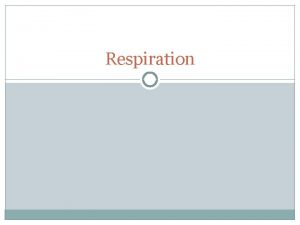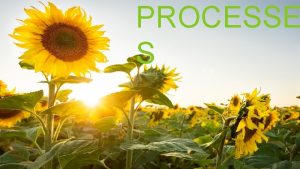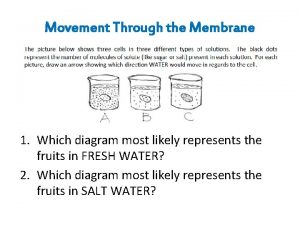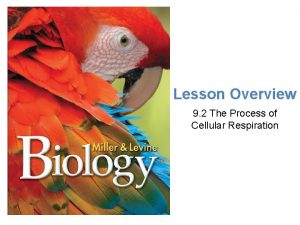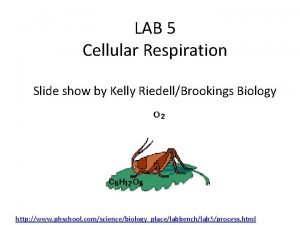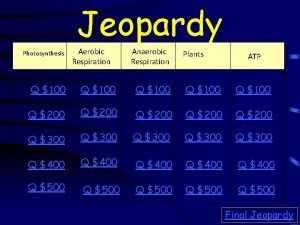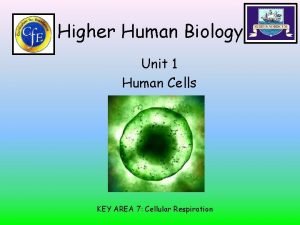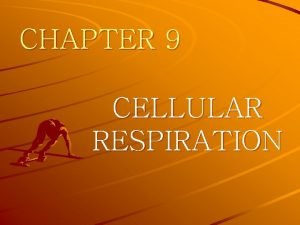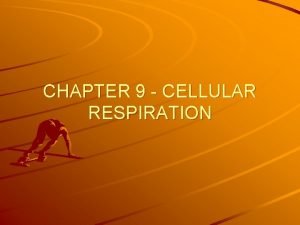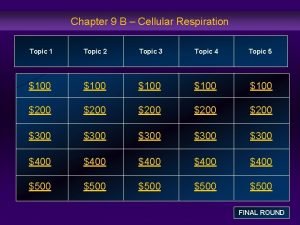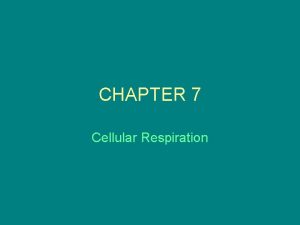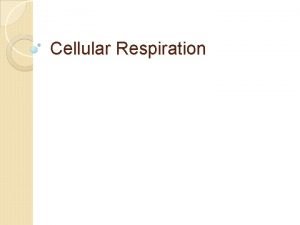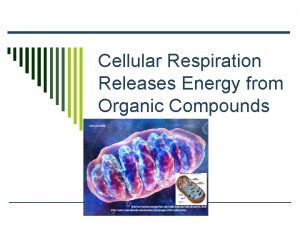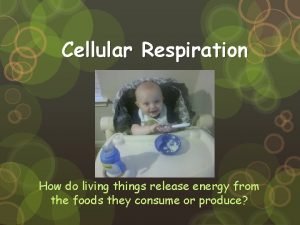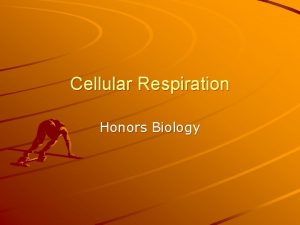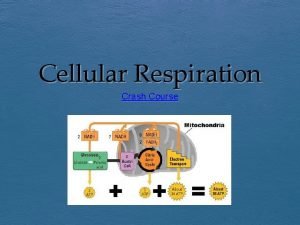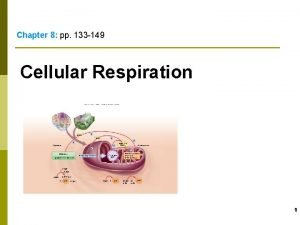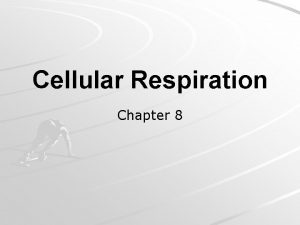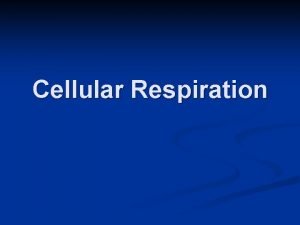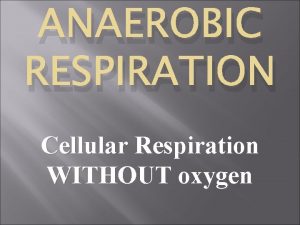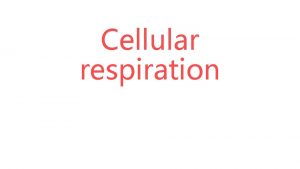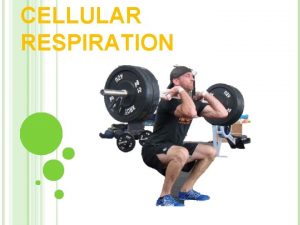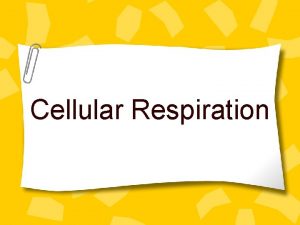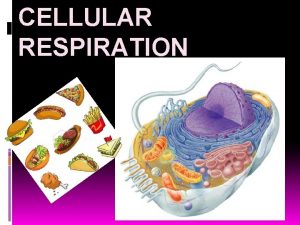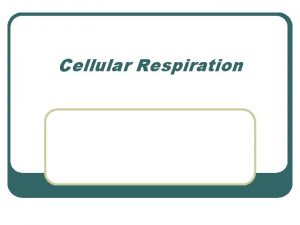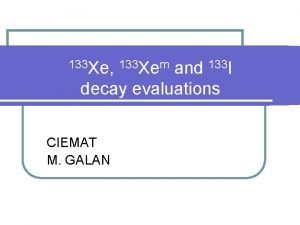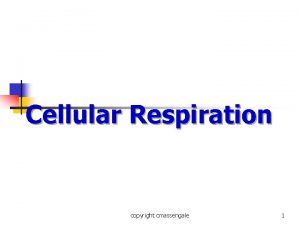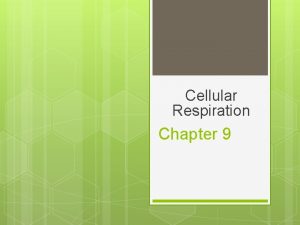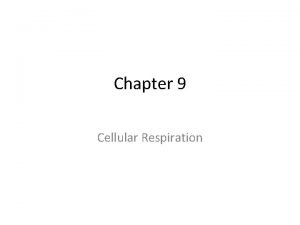Chapter 8 pp 133 149 Cellular Respiration Copyright
































- Slides: 32

Chapter 8: pp. 133 -149 Cellular Respiration Copyright © The Mc. Graw-Hill Companies, Inc. Permission required for reproduction or display. NADH e– e– e– Cytoplasm e– NADH and FADH 2 e– Glycolysis glucose Mitochondrion e– Citric acid cycle Preparatory reaction pyruvate Electron transport chain and chemiosmosis 2 ADP 4 ATP total 4 ADP 2 ATP net gain 2 ADP 2 ATP 32 ADP or 34 32 or 34 ATP 1

Cellular Respiration ◦ NAD+ and FAD ◦ Phases of Cellular Respiration Glycolysis Fermentation Preparatory Reaction Citric Acid Cycle Electron Transport System Metabolic Pool ◦ Catabolism ◦ Anabolism Outline 2

A cellular process that breaks down carbohydrates and other metabolites with the buildup of ATP Consumes oxygen and produces carbon dioxide (CO 2) ◦ Cellular respiration is aerobic process. Usually water involves breakdown of glucose to CO 2 and ◦ Energy extracted from glucose molecule: Released step-wise Allows ATP to be produced efficiently ◦ Oxidation-reduction enzymes include NAD+ and FAD as coenzymes Cellular Respiration 3

NAD+ (nicotinamide adenine dinucleotide) ◦ Called a coenzyme of oxidation-reduction. It can: Oxidize a metabolite by accepting electrons Reduce a metabolite by giving up electrons ◦ Each NAD+ molecule used over and over again FAD (flavin adenine dinucleotide) ◦ Also a coenzyme of oxidation-reduction ◦ Sometimes used instead of NAD+ ◦ Accepts two electrons and two hydrogen ions (H+) to become FADH 2 NAD+ and FAD 4

Phases of Cellular Respiration Cellular respiration includes four phases: ◦ Glycolysis is the breakdown of glucose into two molecules of pyruvate Occurs in cytoplasm ATP is formed Does not utilize oxygen ◦ Transition (preparatory) reaction Both pyruvates are oxidized and enter mitochondria Electron energy is stored in NADH Two carbons are released as CO 2 (one from each pyruvate) 5

◦ Citric acid cycle Occurs in the matrix of the mitochondrion and produces NADH and FADH 2 In series of reaction releases 4 carbons as CO 2 Turns twice (once for each pyruvate) Produces two immediate ATP molecules per glucose molecule ◦ Electron transport chain Extracts energy from NADH & FADH 2 Passes electrons from higher to lower energy states Produces 32 or 34 molecules of ATP Phases of Cellular Respiration 6

Glucose Breakdown: Overview of 4 Phases Copyright © The Mc. Graw-Hill Companies, Inc. Permission required for reproduction or display NADH e– e– Cytoplasm e– NADH and FADH 2 e– Glycolysis glucose Mitochondrion e– Citric acid cycle Preparatory reaction pyruvate Electron transport chain and chemiosmosis 2 ATP 4 ATP total 4 ADP 2 ATP net gain 2 ADP 2 ATP 32 ADP or 34 32 or 34 ATP 7

Occurs in cytoplasm outside mitochondria Energy Investment Steps: ◦ Two ATP are used to activate glucose ◦ Glucose splits into two G 3 P molecules Energy Harvesting Steps: ◦ Oxidation of G 3 P occurs by removal of electrons and hydrogen ions ◦ Two electrons and one hydrogen ion are accepted by NAD+ resulting two NADH ◦ Four ATP produced by substrate-level phosphorylation ◦ Net gain of two ATP ◦ Both G 3 Ps converted to pyruvates Glucose Breakdown: Glycolysis 8

Glycolysis: Inputs and Outputs Copyright © The Mc. Graw-Hill Companies, Inc. Permission required for reproduction or display inputs Glycolysis outputs glucose 2 pyruvate 2 NADH 2 NAD+ 2 ATP 2 ADP 4 ADP + 4 P 4 ATP total 2 ATP net gain 9

Please note that due to differing operating systems, some animations will not appear until the presentation is viewed in Presentation Mode (Slide Show view). You may see blank slides in the “Normal” or “Slide Sorter” views. All animations will appear after viewing in Presentation Mode and playing each animation. Most animations will require the latest version of the Flash Player, which is available at http: //get. adobe. com/flashplayer. Animation 10

Pyruvate If O 2 is not available to the cell, fermentation, an anaerobic process, occurs in the cytoplasm. ◦ During fermentation, glucose is incompletely metabolized to lactate, or to CO 2 and alcohol (depending on the organism). If O 2 is available to the cell, pyruvate enters mitochondria by aerobic process. Pyruvate 11

◦ ◦ An anaerobic process that reduces pyruvate to either lactate or alcohol and CO 2 NADH passes its electrons to pyruvate Alcoholic fermentation, carried out by yeasts, produces carbon dioxide and ethyl alcohol Used in the production of alcoholic spirits and breads. Lactic acid fermentation, carried out by certain bacteria and fungi, produces lactic acid (lactate) Used commercially in the production of cheese, yogurt, and sauerkraut. Other bacteria produce chemicals anaerobically, including isopropanol, butyric acid, proprionic acid, and acetic acid. Fermentation 12

Advantages ◦ Provides a quick burst of ATP energy for muscular activity. Disadvantages ◦ Lactate is toxic to cells. ◦ Lactate changes p. H and causes muscles to fatigue. ◦ Oxygen debt and cramping Efficiency of Fermentation ◦ Two ATP produced per glucose of molecule during fermentation is equivalent to 14. 6 kcal. Fermentation 13

Efficiency of Fermentation Copyright © The Mc. Graw-Hill Companies, Inc. Permission required for reproduction or display. inputs Fermentation glucose 2 ADP + 2 P 2 outputs 2 lactate or 2 alcohol and 2 CO 2 ATP net gain 14

Connects glycolysis to the citric acid cycle End product of glycolysis, pyruvate, enters the mitochondrial matrix Pyruvate converted to 2 -carbon acetyl group ◦ Attached to Coenzyme A to form acetyl-Co. A ◦ Electron picked up (as hydrogen atom) by NAD+ ◦ CO 2 released, and transported out of mitochondria into the cytoplasm The Preparatory (Prep) Reaction 15

Preparatory Reaction Copyright © The Mc. Graw-Hill Companies, Inc. Permission required for reproduction or display. 2 NAD+ O 2 C C OH O + 2 Co. A CH 3 pyruvate 2 pyruvate + 2 Co. A 2 NADH Co. A 2 C O + 2 CO 2 CH 3 carbon acetyl Co. A dioxide 2 acetyl Co. A + 2 carbon dioxide 16

Please note that due to differing operating systems, some animations will not appear until the presentation is viewed in Presentation Mode (Slide Show view). You may see blank slides in the “Normal” or “Slide Sorter” views. All animations will appear after viewing in Presentation Mode and playing each animation. Most animations will require the latest version of the Flash Player, which is available at http: //get. adobe. com/flashplayer. Animation 17

Mitochondrion: Structure & Function Copyright © The Mc. Graw-Hill Companies, Inc. Permission required for reproduction or display. Cristae: location of the electron transport chain (ETC) Matrix: location of the prep reaction and the citric acid cycle outer membrane inner membrane intermembrane space cristae matrix 45, 000 © Dr. Donald Fawcett and Dr. Porter/Visuals Unlimited 18

Glucose Breakdown: The Citric Acid Cycle A. Krebs cycle Occurs in matrix of mitochondria Begins by the addition of a two-carbon acetyl group to a four-carbon molecule (oxaloacetate), forming a six-carbon molecule (citric acid) NADH, FADH 2 capture energy rich electrons ATP formed by substrate-level phosphorylation Turns twice for one glucose molecule. Produces 4 CO 2, 2 ATP, 6 NADH and 2 FADH 2 (per glucose molecule) 19

Please note that due to differing operating systems, some animations will not appear until the presentation is viewed in Presentation Mode (Slide Show view). You may see blank slides in the “Normal” or “Slide Sorter” views. All animations will appear after viewing in Presentation Mode and playing each animation. Most animations will require the latest version of the Flash Player, which is available at http: //get. adobe. com/flashplayer. Animation 20

Citric Acid Cycle: Balance Sheet Copyright © The Mc. Graw-Hill Companies, Inc. Permission required for reproduction or display. inputs Citric acid cycle outputs 4 CO 2 6 NADH 2 acetyl groups 6 NAD+ 2 FAD 2 ADP + 2 P 2 2 FADH 2 ATP

Location: ◦ Eukaryotes: cristae of the mitochondria ◦ Aerobic Prokaryotes: plasma membrane Series of carrier molecules: ◦ Pass energy rich electrons successively from one to another ◦ Complex arrays of protein and cytochromes Cytochromes are respiratory molecules Complex carbon rings with metal atoms in center Receives electrons from NADH & FADH 2 Produce ATP by oxidative phosphorylation Oxygen serves as a final electron acceptor ◦ Oxygen ion combines with hydrogen ions to form water Electron Transport Chain 22

Please note that due to differing operating systems, some animations will not appear until the presentation is viewed in Presentation Mode (Slide Show view). You may see blank slides in the “Normal” or “Slide Sorter” views. All animations will appear after viewing in Presentation Mode and playing each animation. Most animations will require the latest version of the Flash Player, which is available at http: //get. adobe. com/flashplayer. Animation

The fate of Hydrogens the hydrogens: from NADH deliver enough energy to make 3 ATPs ◦ Those from FADH 2 have only enough for 2 ATPs ◦ “Spent” hydrogens combine with oxygen Recycling of coenzymes increases efficiency ◦ Once NADH delivers hydrogens, it returns (as NAD+) to pick up more hydrogens ◦ However, hydrogens must be combined with oxygen to make water ◦ If O 2 not present, NADH cannot release H ◦ No longer recycled back to NAD+ Electron Transport Chain 24

Glucose Catabolism: Overall Energy Yield Net yield per glucose: ◦ From glycolysis – 2 ATP ◦ From citric acid cycle – 2 ATP ◦ From electron transport chain – 32 ATP Energy content: ◦ Reactant (glucose) 686 kcal ◦ Energy yield (36 ATP) 263 kcal ◦ Efficiency 39%; balance is waste heat 25

Overall Energy Yielded per Glucose Molecule Copyright © The Mc. Graw-Hill Companies, Inc. Permission required for reproduction or display. 2 net ATP glycolysis 2 NADH 6 NADH 2 FADH 2 pyruvate Mitochondrion 2 acetyl Co. A 2 CO 2 2 ATP Citric acid cycle 4 CO 2 ATP 6 ATP 18 ATP 4 ATPP 2 6 O 2 subtotal 4 4 or 6 Electron transport chain Cytoplasm glucose 6 H 2 O subtotal 32 or 34 ATP 36 or 38 total ATP 26

Foods: ◦ Sources of energy rich molecules ◦ Carbohydrates, fats, and proteins Degradative reactions (Catabolism) break down molecules ◦ Tend to be exergonic (release energy) Synthetic molecules reactions (anabolism) build ◦ Tend to be endergonic (consume energy) Metabolic Pool: Catabolism 27

Glucose is broken down in cellular Fat breaks down into glycerol and respiration. three fatty acids. Amino acids break down into carbon chains and amino groups ◦ Deaminated (NH 2 removed) in liver Results in poisonous ammonia (NH 3) Quickly converted to urea ◦ Different R-groups from AAs processed differently ◦ Fragments enter respiratory pathways at many different points Metabolic Pool: Catabolism 28

All metabolic reactions part of metabolic pool Intermediates from respiratory pathways can be used for anabolism Anabolism (build-up side of metabolism): ◦ Carbs: Start with acetyl-Co. A Basically reverses glycolysis (but different pathway) ◦ Fats G 3 P converted to glycerol Acetyls connected in pairs to form fatty acids Note – dietary carbohydrate RARELY converted to fat in humans! Metabolic Pool: Anabolism 29

Anabolism (cont. ): ◦ Proteins: Made up of combinations of 20 different amino acids Some amino acids (11) can be synthesized from respiratory intermediates ◦ Organic acids in citric acid cycle can make amino acids ◦ Add NH 2 – transamination However, other amino acids (9) cannot be synthesized by humans ◦ Essential amino acids ◦ Must be present in diet or die Metabolic Pool: Anabolism 30

Photosynthesis vs. Cellular Respiration Copyright © The Mc. Graw-Hill Companies, Inc. Permission required for reproduction or display. Photosynthesis H 2 O Cellular Respiration membranes O 2 H 2 O 2 grana cristae ADP NADPH O ATP NADP+ NADH enzymes CO 2 CH 2 O CO 2 31

Chapter 8: pp. 133 - 149 Cellular Respiration Copyright © The Mc. Graw-Hill Companies, Inc. Permission required for reproduction or display. NADH e– e– e– Cytoplasm e– NADH and FADH 2 e– Glycolysis glucose Mitochondrion e– Citric acid cycle Preparatory reaction pyruvate Electron transport chain and chemiosmosis 2 ADP 4 ATP total 4 ADP 2 ATP net gain 2 ADP 2 ATP 32 ADP or 34 32 or 34 ATP 32
 Chapter 8 section 3 cellular respiration
Chapter 8 section 3 cellular respiration Chapter 9 cellular respiration harvesting chemical energy
Chapter 9 cellular respiration harvesting chemical energy Chapter 9 cellular respiration harvesting chemical energy
Chapter 9 cellular respiration harvesting chemical energy Chapter 9: cellular respiration: harvesting chemical energy
Chapter 9: cellular respiration: harvesting chemical energy Redox reaction in cellular respiration
Redox reaction in cellular respiration The gray-brown haze often found over large cities is called
The gray-brown haze often found over large cities is called Chemiosmosis steps
Chemiosmosis steps Types of respiration
Types of respiration Fermentation process
Fermentation process Why is cellular respiration important
Why is cellular respiration important Complimentary processes
Complimentary processes What's the equation for cellular respiration
What's the equation for cellular respiration How are internal and external respiration alike
How are internal and external respiration alike Are photosynthesis and cellular respiration opposites
Are photosynthesis and cellular respiration opposites Photosynthesis recipe card
Photosynthesis recipe card What happens during glycolysis
What happens during glycolysis Overview of cellular respiration
Overview of cellular respiration Respiration overview
Respiration overview Cellular respiration
Cellular respiration Cellular respiration
Cellular respiration Lab bench cellular respiration
Lab bench cellular respiration What is the word equation for cellular respiration
What is the word equation for cellular respiration Higher human biology cellular respiration
Higher human biology cellular respiration Equation of cellular respiration
Equation of cellular respiration What are the reactants and products of photosynthesis?
What are the reactants and products of photosynthesis? Cellular respiration releases
Cellular respiration releases Starting materials for cellular respiration
Starting materials for cellular respiration Redox reaction in cellular respiration
Redox reaction in cellular respiration Cellular respiration formula
Cellular respiration formula Role of cellular respiration
Role of cellular respiration Cellular respiration releases
Cellular respiration releases Cellular respiration redox
Cellular respiration redox Cell respiration crash course
Cell respiration crash course







